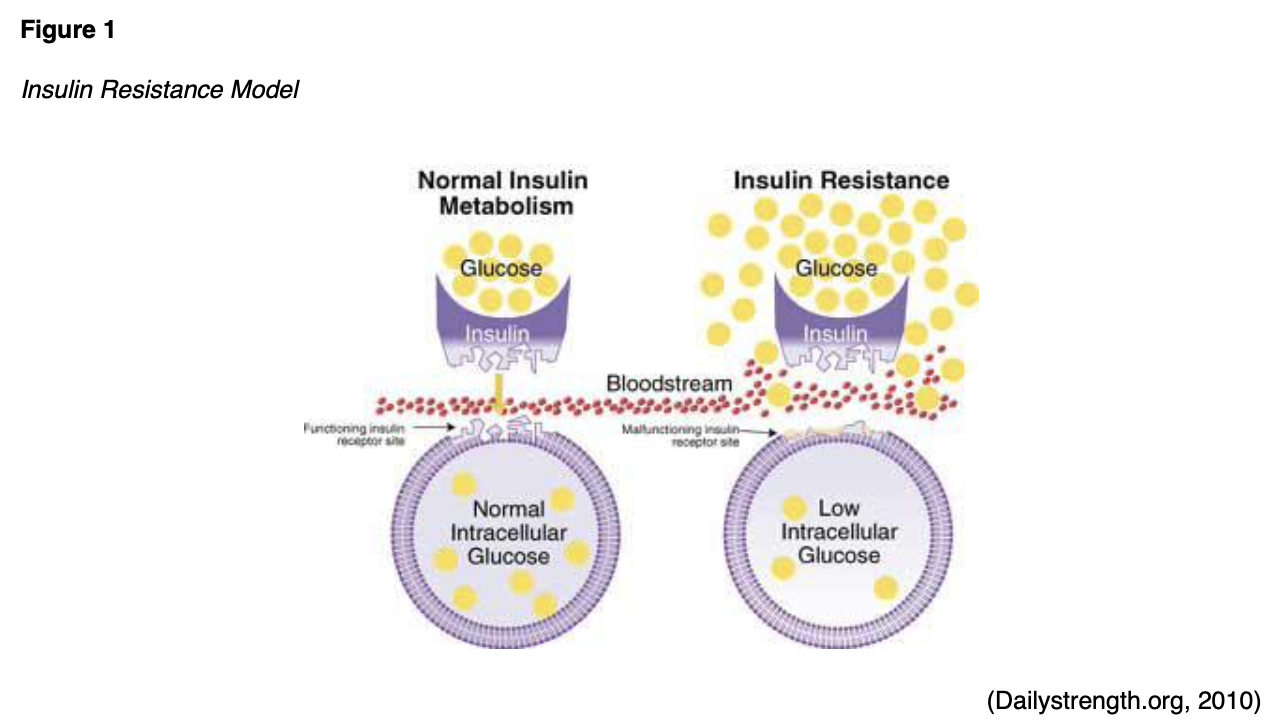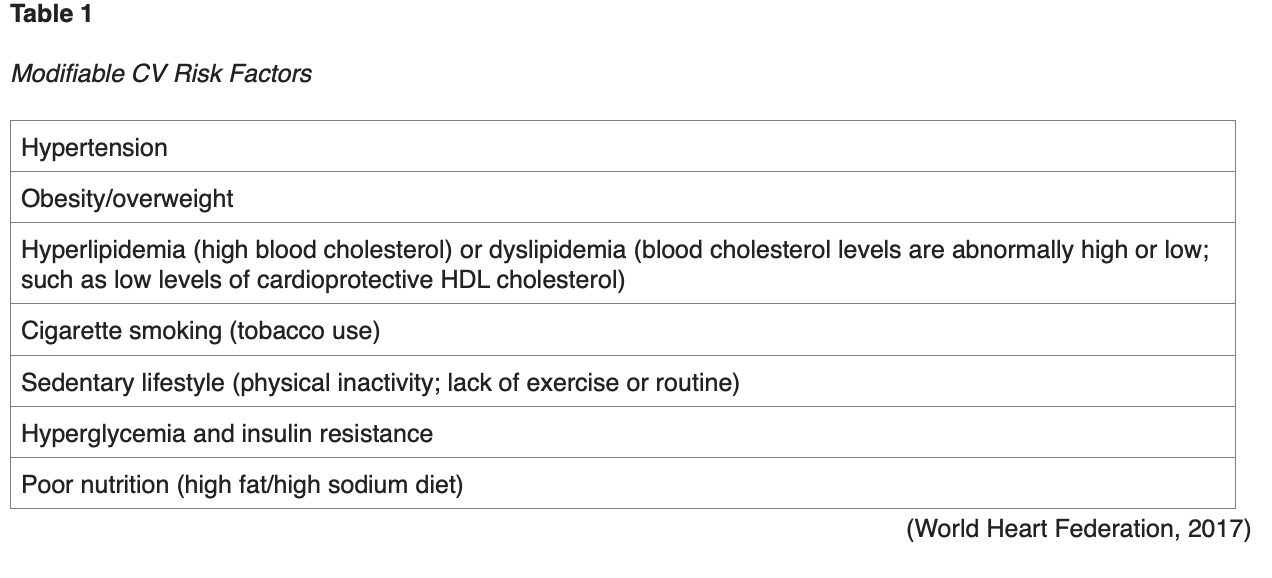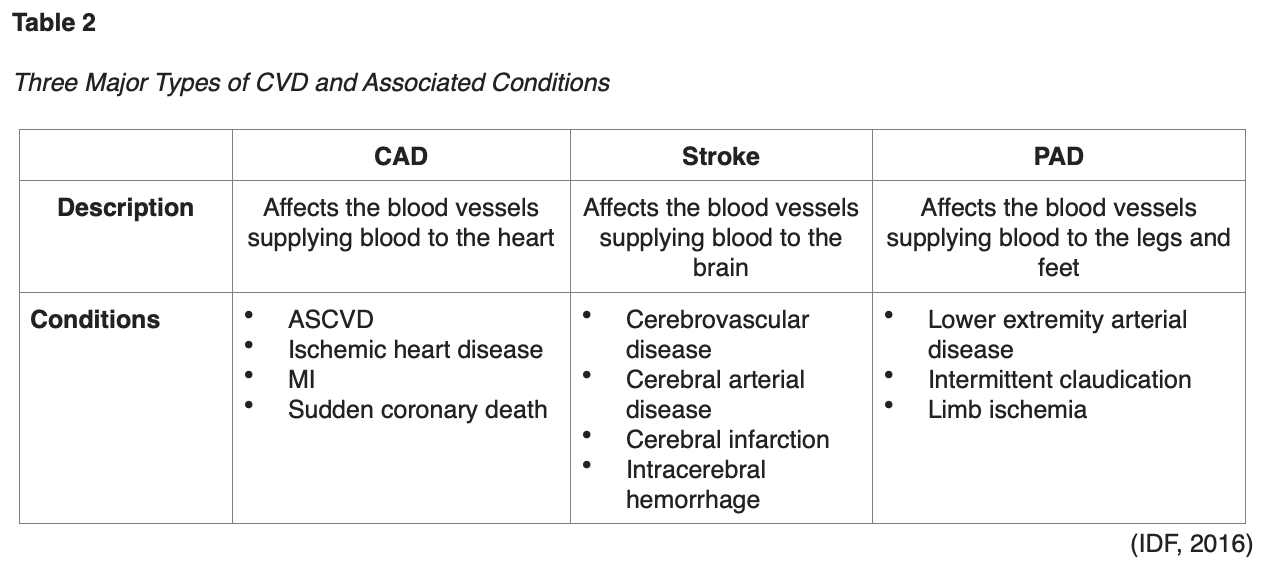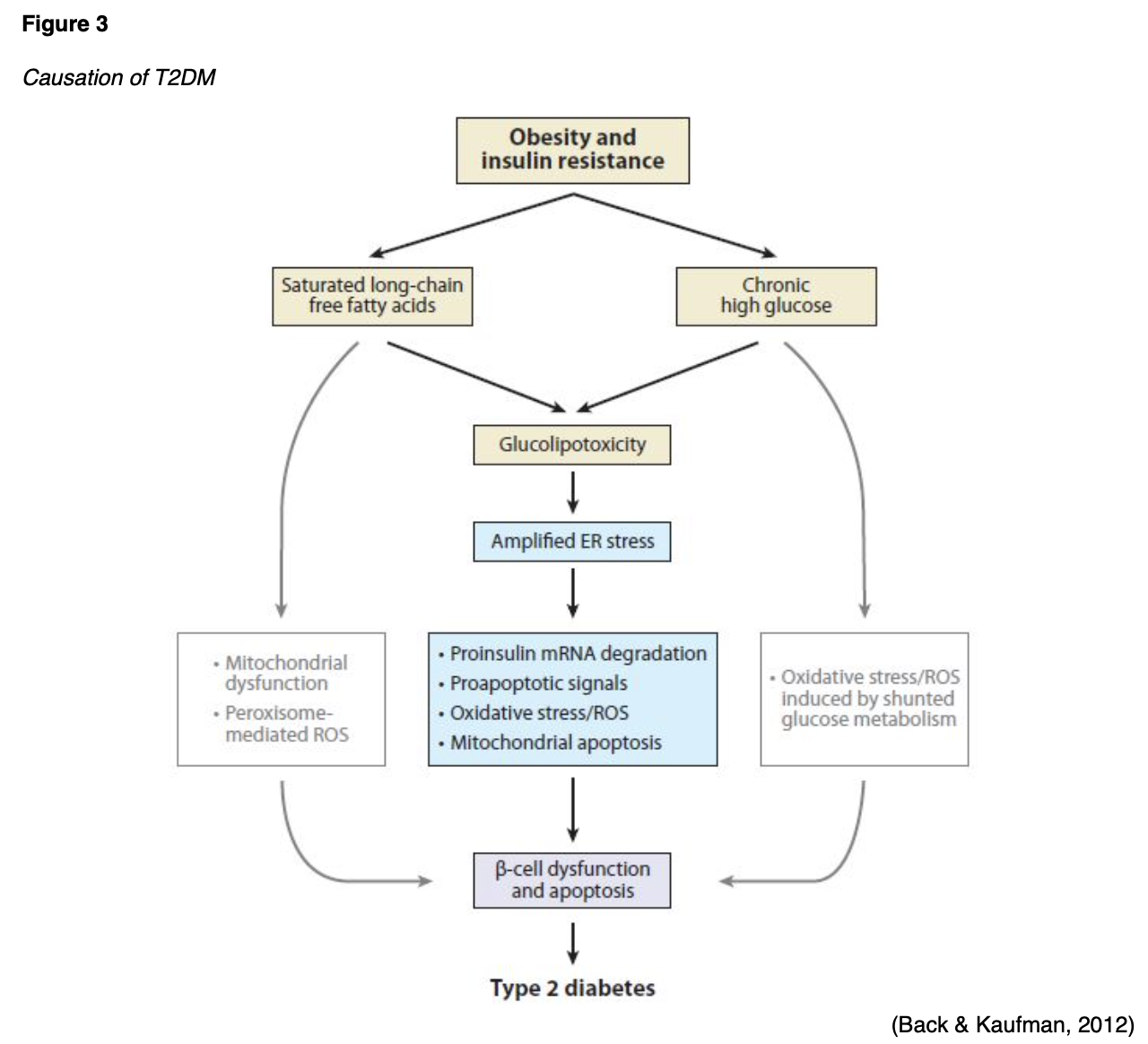The purpose of this module is to describe the pathophysiology of cardiovascular disease (CVD) in type 2 diabetes mellitus (T2DM), review the national guidelines for optimum cardiovascular (CV) health in diabetes, and describe the American Diabetes Association (ADA) recommendations for management of diabetic patients with CVD, including an overview of recommended medications and key patient teaching points on lowering CV risks.
...purchase below to continue the course
tty acid release, insulin resistance, increased levels of low-density lipoprotein (LDL) cholesterol in the blood, oxidative stress, and tobacco use. As demonstrated in Figure 4, endothelial dysfunction promotes leukocyte and platelet adhesion, thrombosis, and inflammation. Activation of these systems impairs normal functioning, increases vasoconstriction, promotes inflammation and thrombosis, thereby rendering arteries susceptible to atherosclerosis (Katakami, 2018).
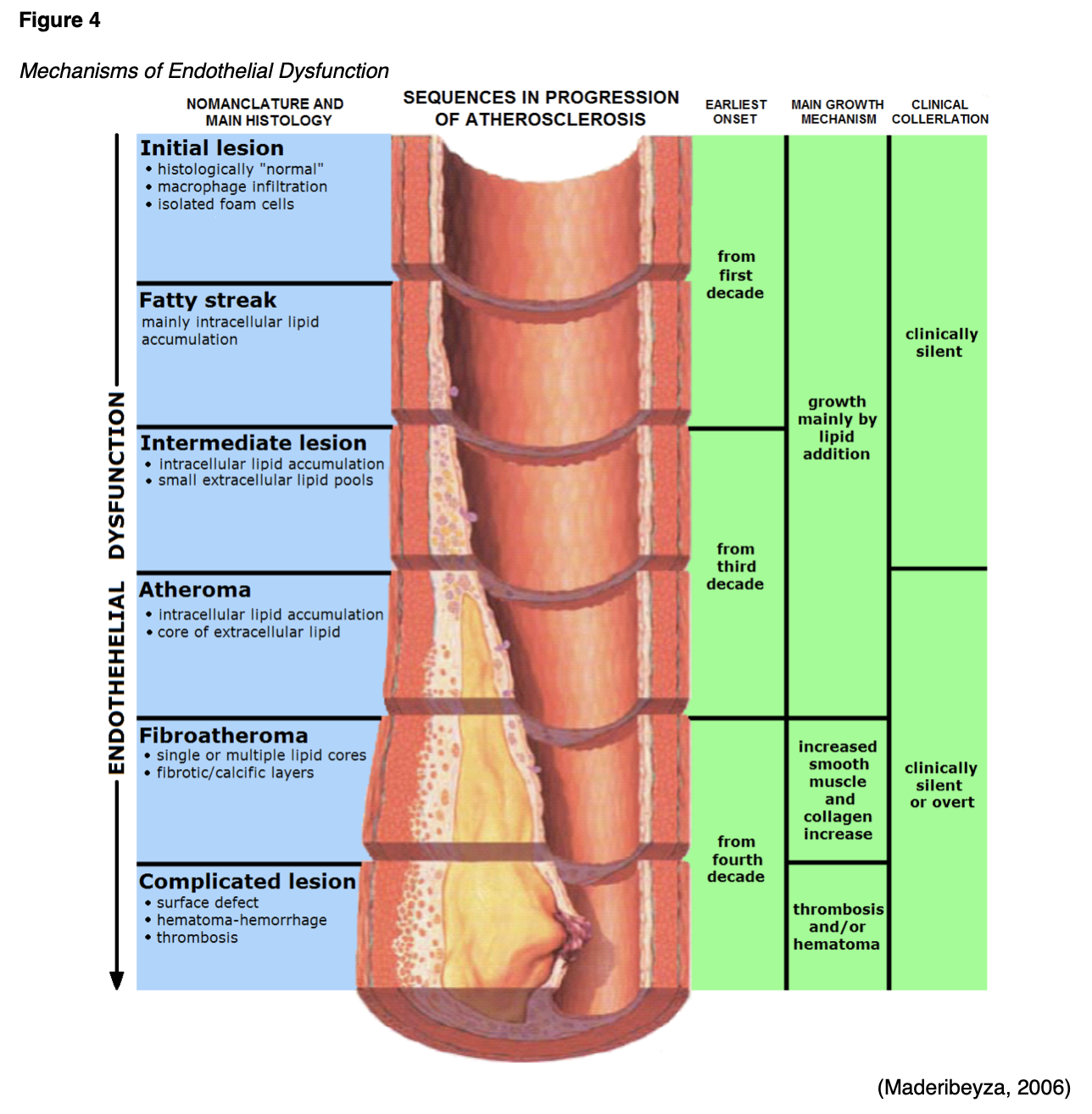
Chronic hyperglycemia and insulin resistance serve important roles in the initiation of vascular complications of diabetes and involve a number of mechanisms, such as: (1) increased formation of advanced glycation end products (AGEs) and activation of the receptor for advanced glycation end products (RAGE) AGE-RAGE axis, (2) oxidative stress, and (3) inflammation (Fishman et al., 2018). Insulin serves an essential dual-action role in maintaining homeostasis of the vasculature, as it stimulates endothelial cell production of nitric oxide (NO), which is a vasodilator that exerts antiaggregatory effects on smooth muscle. Insulin also mediates the release of endothelin (ET-1), which is a strong vasoconstrictor. Under physiological conditions, the actions of insulin are mediated by a vasoprotective signaling pathway called phosphoinositide 3-kinase (PI3K)/Akt. However, when insulin resistance develops, the actions of insulin become mediated by a pathological signaling pathway known as the mitogen-activated protein kinase/extracellular signal-regulated kinase (MAPK/ERK). The MAPK/ERK pathway mediates inflammation, vasoconstriction, and vascular smooth muscle cell proliferation, thereby contributing to the development of the consequential CV byproducts of insulin resistance (Janus et al., 2016). Patients with insulin resistance have higher rates of hyperglycemia, which accelerates plaque formation and accumulation. Acute hyperglycemia reduces NO bioavailability and endothelial-dependent vasodilation, whereas chronic hyperglycemia promotes atherogenesis and accelerates the progression of atherosclerosis (Katakami, 2018). The relationship between hyperglycemia, increased insulin secretion, and the resulting consequences are portrayed in Figure 5.
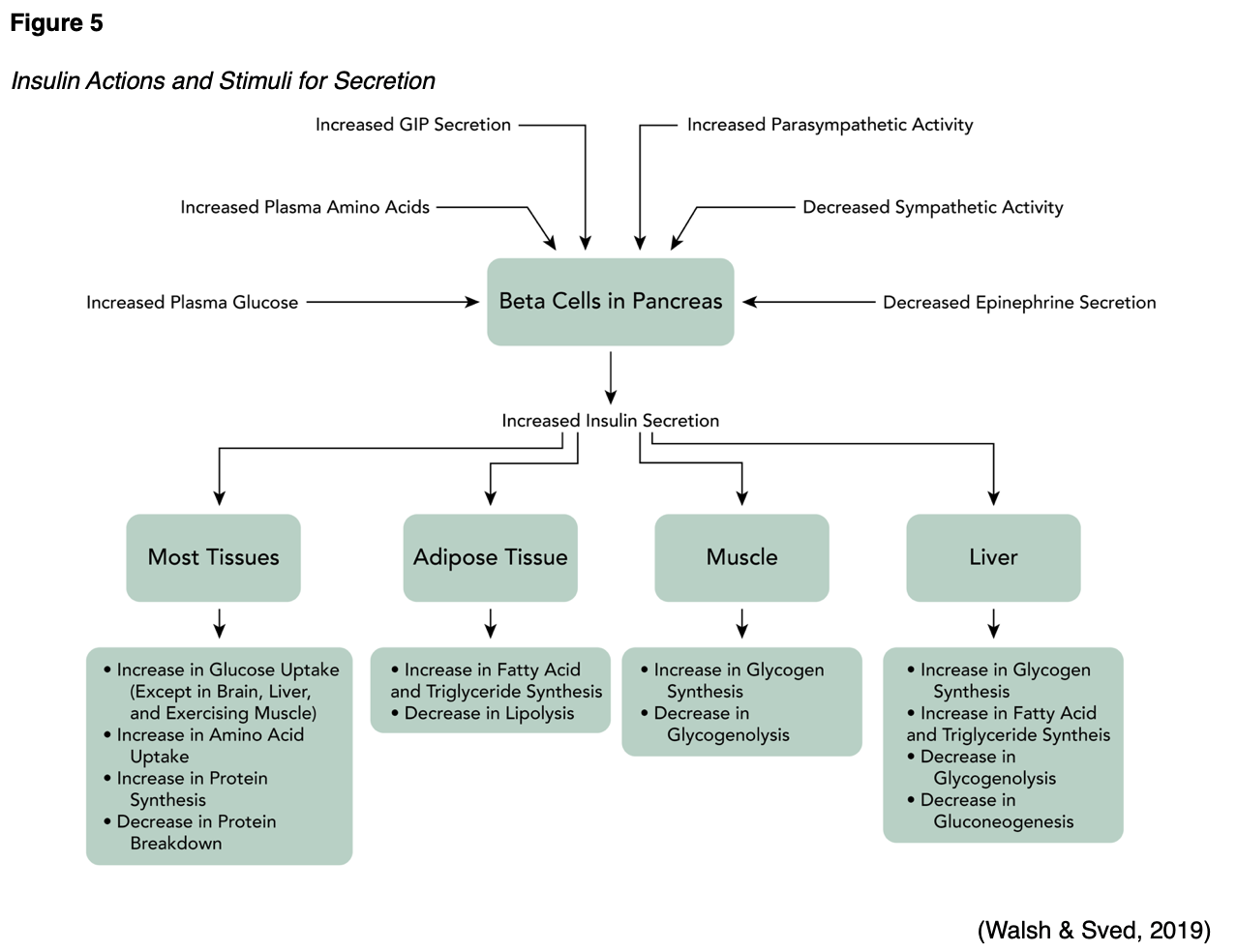
As displayed in Figure 5, T2DM and dyslipidemia commonly occur together and lipid abnormalities affect up to 70% of patients with T2DM (ADA, 2020). Atherosclerosis is also prompted by local inflammation in the vascular wall that is induced by hyperlipidemia, specifically high levels of LDL. Patients with T2DM have a higher prevalence of lipid abnormalities in the peripheral venous circulation, increased amounts of atherosclerotic plaque accumulation, and smaller coronary artery lumen diameter than those without T2DM. Hyperlipidemia within the atherosclerotic plaque results in the recruitment and migration of monocytes and other immune and inflammatory cells into the vascular subendothelial layer. Recruited monocytes differentiate into macrophages or dendritic cells. Activated macrophages express scavenger receptors to facilitate engulfment of both native and oxidized LDL cholesterol, and along with other inflammatory cells, increase the production of chemokines and cytokines. These mechanisms operate to promote atherosclerotic lesion progression within the inflammatory cycle (Janus et al., 2016; Low Wang et al., 2016).
National Guidelines for Optimal CV Health in T2DM
Research has demonstrated that preventing or slowing the progression of CVD in patients with T2DM is based on controlling individual CV risk factors. Studies have consistently demonstrated that lowering the glycated hemoglobin, or hemoglobin A1C (A1C) level, in patients with T2DM has only a minimal effect on reducing CV risks when performed in isolation. Correcting and controlling multiple CV risk factors simultaneously has been shown to markedly reduce CVD mortality in patients with T2DM (Abdul-Ghani et al., 2017). Over the last decade, research has demonstrated a decline in CVD-associated morbidity and mortality when aggressive risk factor modifications are concurrently implemented (ADA, 2020). The ADA's Standards of Care in Diabetes (2020), a national resource for the optimal management of diabetes, includes annual updates on the evidence-based prevention and management of diabetes and diabetes-related complications. Embedded within these standards are specific guidelines on CVD and risk management in patients with T2DM, strongly emphasizing the concurrent control of hyperglycemia, hypertension, and hyperlipidemia as the central targets (ADA, 2020).
CVD Risk Assessment
To improve patient outcomes and effectively manage CV risk in the context of T2DM, the American College of Cardiology (ACC, n.d.) and ADA (2020) cite the following as essential components:
- Expand the narrow focus of glucose control to include a systematic assessment of all CV risk factors (Table 1) at least annually and perform aggressive risk reduction with an emphasis on the close monitoring and control of the ABCs of CV risk (Table 3).
- Encourage and implement an individualized, patient-centered, and collaborative approach to reducing CV risk through shared-decision making and open communication between patients and their healthcare team.
- Employ the ACC/AHA ASCVD risk calculator to better stratify ASCVD risk and help guide therapy. This risk calculator, otherwise referred to as the Risk Estimator Plus, is an online tool that estimates the 10-year risk of a first ASCVD event, accounting for a diagnosis of T2DM as a risk factor (ACC, n.d.; ADA, 2020).
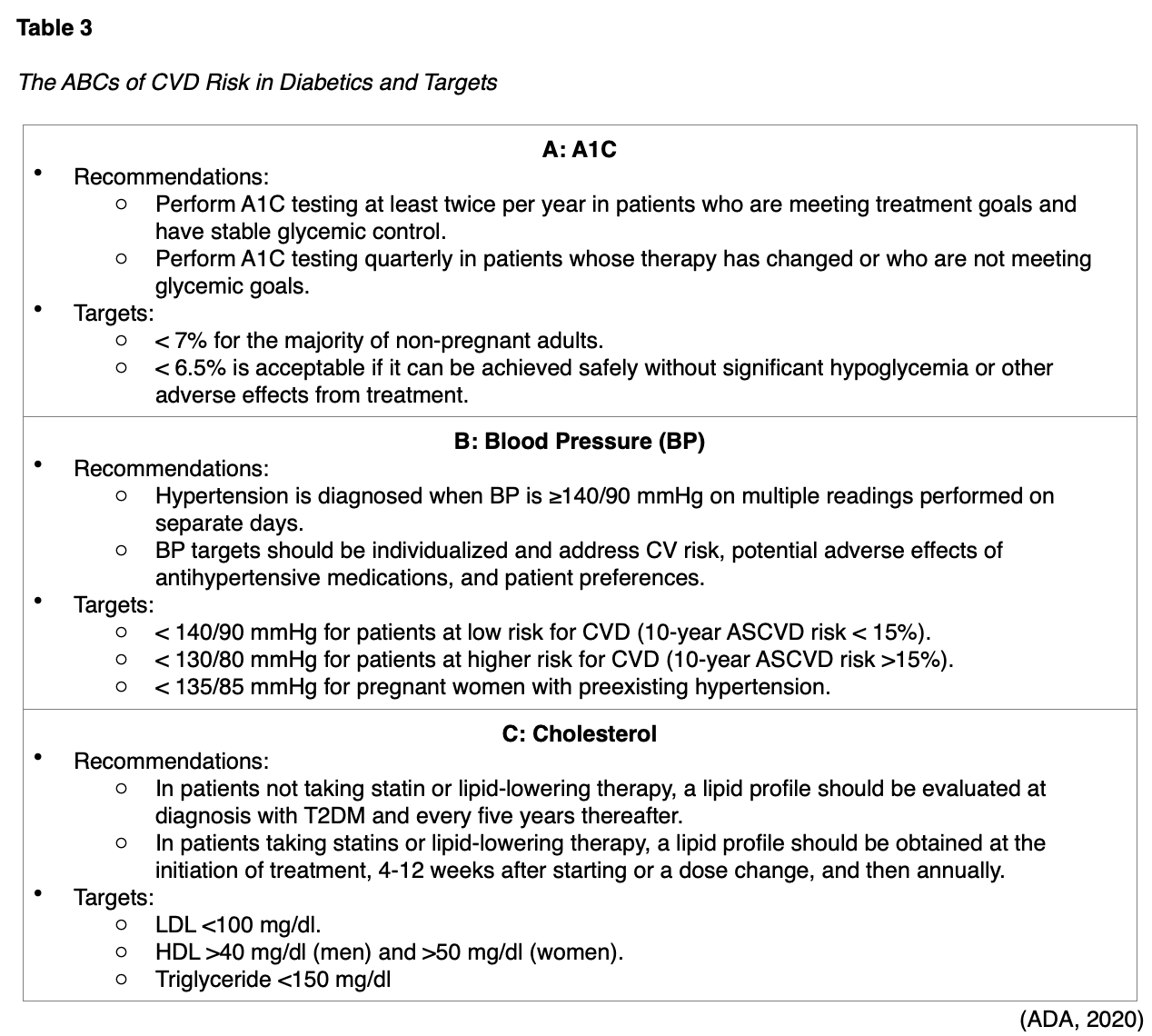
In addition to the above, the following CV risks should be assessed at least annually:
- Smoking: smoking affects microcirculation and accelerates CV complications. Smoking cessation is strongly advised.
- Family history of premature CAD: non-modifiable risk factor for both DM and CVD.
- Chronic kidney disease (CKD): BP control reduces the risk of kidney disease.
- Presence of albuminuria (protein in the urine): albuminuria is a biomarker for CVD and coronary events (ADA, 2020).
Treatment/Management
The ACC (2018) cites six steps for optimizing CV risk reduction among patients with T2DM when developing the individualized treatment plan:
- Educate patients with T2DM about CV risks (beyond poor glucose control) that might contribute to and accelerate CV damage (Table 1).
- Empower patients to act by setting personal goals for lowering CV risk.
- Create an individualized plan to assess and manage CV risk on an ongoing basis and revisit this plan over time to reevaluate and update to promote compliance.
- Ensure adequate glycemic control is obtained by developing a realistic plan for lifestyle changes and adhering to prescribed glucose-lowering medications.
- Consider adding novel antihyperglycemic agents when appropriate (discussed in next section).
- Assess adherence and identify hurdles, such as cost, side effects, personal preferences, or treatment complexity (ACC, n.d.).
Lifestyle Management
Lifestyle management strategies for T2DM and CVD risk reduction should begin at the initial patient contact and should be implemented across the spectrum of care, preventatively, and as part of the treatment plan in collaboration with medication therapy. The combination of lifestyle and pharmacologic therapy enhances treatment efficacy, aids in the control of CV risk factors, thereby more successfully reducing morbidity and mortality. Nurses should engage patients in shared decision-making to develop appropriate goals and determine realistic treatment plans across the trajectory of their diabetes care. Heart-healthy lifestyle interventions are advised for all patients with T2DM as a means of reducing CV risk. The ADA (2020) recommends the following lifestyle recommendations:
- Glucose monitoring is key for achieving glycemic targets for many patients with T2DM. Self-monitoring of blood glucose (SMBG) may help with self-management and medication adjustment, and diabetes self-management education (DSME) should be patient-centered and help guide clinical decisions.
- Reduce excess body weight through caloric restriction (losing 5% of body weight can benefit glycemic control, lipids, and blood pressure).
- Follow the Dietary Approaches to Stop Hypertension (DASH) eating pattern to reduce intake of sodium (less than 2,300 mg/day).
- Increase dietary consumption of fruits and vegetables (eight to ten servings/day).
- Moderate alcohol intake (no more than two servings/day for men, and no more than one serving/day for women).
- Increase physical activity (150 minutes or more of moderate-to-vigorous intensive aerobic activity each week) (ACC, n.d.; ADA, 2020).
Evidence-Based Recommendations for Lowering CVD Risk
While lifestyle interventions and modifications are essential, gaining control over T2DM and reducing CV risk commonly requires adjunctive pharmacologic therapy. CV risk reduction in T2DM is largely premised on four categories: (1) antiplatelet therapy, (2) antihypertensives, (3) lipid-lowering agents, and (4) antihyperglycemics.
Antiplatelet Therapy
Antiplatelet therapy is used to thin the blood, so it is less likely to clot and clog blood vessels, thereby reducing the risk of stroke or MI. The most common and well-studied form of antiplatelet therapy is low dose acetylsalicylic acid (ASA), or aspirin. For patients with documented acetylsalicylic acid (ASA) allergy, P2Y12 inhibitors, such as clopidogrel (Plavix) are recommended alternatives (ADA, 2020). Acetylsalicylic acid (ASA) has demonstrated efficacy in reducing CV morbidity and mortality in high-risk patients who have endured a prior MI or stroke and is strongly recommended for secondary prevention. In primary prevention, among patients with no prior CV events, the benefits are less clear, and its use is more controversial (ADA, 2020).
Aspirin. Acetylsalicylic acid (ASA) is an over the counter (OTC) nonsteroidal anti-inflammatory drug (NSAID) that is widely used to treat several conditions such as fever, pain, and inflammation. Acetylsalicylic acid (ASA) functions to reduce CV risk by blocking the enzyme that makes prostaglandins (cyclooxygenase), thereby reducing concentrations of prostaglandins, and lowering levels of pain, inflammation, and body temperature. Since acetylsalicylic acid (ASA) is a potent inhibitor of both prostaglandin synthesis and platelet aggregation, it inhibits platelets for the entire cell lifespan of seven to ten days. Therefore, it decelerates the blood's clotting action by reducing the clumping of platelets. Acetylsalicylic acid (ASA) inhibits the function of platelets in a manner different from other NSAIDs such as ibuprofen (Motrin), as its antithrombotic effects last longer, making it the ideal agent for MI and stroke reduction (MedicineNet, n.d.). There is a risk for bleeding events in patients taking acetylsalicylic acid (ASA), particularly gastrointestinal (GI) bleeding. The drug is listed within Beers Criteria and should be used with caution (or avoided) in older adults due to its bleeding effects. The risk for GI bleeding is increased in certain high-risk individuals. Aside from GI bleeding, the most common side effect is tinnitus (ringing in the ears). Enteric-coated formulations of acetylsalicylic acid (ASA) are considered safer with regards to the risk for GI bleeding, as they are designed to pass through the stomach and not disintegrate until it reaches the small intestine. Acetylsalicylic acid (ASA) may cause a severe allergic reaction, causing hives, facial swelling, shock, or asthma (wheezing). Children, adolescents, and young adults under the age of 21 who have or are recovering from chickenpox or flu-like syndromes should not take aspirin due to risk for a rare but serious illness known as Reye's syndrome (Mayo Clinic, 2019a).
P2Y12 Inhibitors. P2Y12 inhibitors are a group of antiplatelet drugs that may be used in place of acetylsalicylic acid (ASA) for patients with an allergy or other contraindication. Clopidogrel (Plavix) is the most widely used and studied P2Y12 inhibitor for reducing CV risk and it works by binding to the P2Y12 receptor on platelets, preventing adenosine diphosphate (ADP) from activating platelets. The tolerability and side effects of clopidogrel (Plavix) are similar to that of acetylsalicylic acid (ASA), as it also poses a risk for bleeding events, particularly GI bleeding and ulcers (MedlinePlus, 2018).
Antihypertensive Medications
Several studies have demonstrated that antihypertensive therapy to maintain the BP below 140/90 mmHg reduces CV events as well as microvascular complications in patients with T2DM. Treatment should focus on controlling BP to achieve individualized targets utilizing drug classes demonstrated to reduce CV events. These agents include angiotensin-converting enzyme inhibitors (ACEIs), angiotensin II receptor blockers (ARBs), thiazide-like diuretics, or dihydropyridine calcium channel blockers (CCBs). ACEIs and ARBs are considered first-line antihypertensive agents in patients with T2DM, as they not only function to lower the blood pressure but also have an effect on reducing the risk of kidney dysfunction from microvascular complications. The most common side effect of ACEIs includes cough, which occurs in up to 37% of patients and is the most common reason for drug discontinuation. Other side effects include dizziness, fatigue, headaches, hypotension, loss of taste, and hyperkalemia. There is also a rare adverse effect of angioedema (swelling of airway) occurs in less than 1% of patients. (Yancy et al., 2017). The side effects of ARBs are very similar to ACEIs; however, cough occurs less frequently with these medications. Rare adverse effects include liver failure, neutropenia, thrombocytopenia, and rhabdomyolysis (destruction of skeletal muscles).
Angioedema is less common than with ACEIs, but still possible. With thiazide-like diuretics, the most common side effects include dizziness, lightheadedness, anorexia, weakness, headache, blurred vision, and photosensitivity (increased sensitivity to sunlight). The nurse should advise patients to avoid certain NSAIDs such as ibuprofen (Motrin) and naproxen (Naprosyn), as these medications can reduce the effectiveness of the diuretics (Scheen, 2018). For CCBs, the most common side effects include headache, lightheadedness, flushing, and peripheral edema in up to 30% of patients, but the majority of these effects are dose dependent, so lower doses are better tolerated. Chronic use of CCBs can also lead to gingival hyperplasia in some patients (Bloch & Basile, 2020). The ADA (2020) cautions that BP targets more aggressive than < 140/90 mmHg are not likely to improve CV outcomes among most patients with T2DM and are more likely to contribute to adverse effects and costs (ADA, 2020). The specifics of initial treatment for hypertension depends upon the severity of hypertension and clinical risk factors (ADA, 2020).
Resistant hypertension is defined as a BP above 139/89 mmHg despite three classes of antihypertensive medications, including a thiazide-like diuretic (ADA, 2020). Numerous studies have demonstrated that primary aldosteronism and hyperaldosteronism are common mechanisms in patients with resistant hypertension. Mineralocorticoid receptor antagonists (MRAs) have well-established benefits with regards to their efficacy in the management of resistant hypertension. MRAs are shown to be effective in acting on the renin-angiotensin-aldosterone pathway, providing CV and renal protection. Spironolactone (Aldactone) and eplerenone (Inspra) are the two most extensively studied MRAs in the management of resistant hypertension. MRAs are classified as potassium-sparing diuretics, as they function to prevent the body from absorbing too much salt and avert potassium excretion. These drugs bind to the androgen receptors to prevent their interaction with testosterone. Therefore, common side effects include gynecomastia, breast pains, erectile dysfunction, and menstrual irregularities, occurring in up to 9% of patients, and are reversible upon discontinuation of the drug (Yugar-Toledo et al., 2017). These side effects are most common with spironolactone (Aldactone), the prototype of MRAs, which has been the subject of numerous studies over time with demonstrated efficacy. Eplerenone (Inspra) is a less potent second-generation selective MRA, so it has a higher affinity for the mineralocorticoid receptor and a lower affinity for androgen receptors than spironolactone (Aldactone) (Dudenbostel & Calhoun, 2017). The most common adverse effect among all MRAs is hyperkalemia, so monitoring of serum creatinine and potassium levels is typical (ADA, 2020). Additional side effects include drowsiness, lightheadedness, blurred vision, nausea, vomiting, diarrhea, headache, increased thirst, and orthostatic hypotension (Yugar-Toledo et al., 2017).
Statins or Other Lipid-Lowering Therapy
There is significant evidence to support the critical importance of reducing LDL levels as one of the most effective ways to reduce ASCVD. Statins are the preferred first-line pharmacologic therapy for most patients with T2DM due to their well-established benefits on lowering LDL cholesterol and cardioprotective factors (ADA, 2020). They work by inhibiting hydroxymethylglutaryl-coenzyme A (HMG-CoA) reductase, which is the enzyme in the cholesterol biosynthesis pathway. While statins are highly effective at lowering LDL, they are associated with fair levels of toxicity. The most common adverse effect and reason for discontinuation of statin therapy is statin-associated muscle symptoms (SAMSs); up to 72% of all statin adverse events are muscle related. SAMSs can present as myalgia, myopathy, myositis with elevated creatinine kinase, or in its most severe form, rhabdomyolysis. Other side effects include joint and abdominal pain, neurological and neurocognitive effects, hepatotoxicity, and renal toxicity (Ward et al., 2019). While there are other lipid-lowering agents available, the evidence for the use of drugs that target these lipid fractions is not nearly as rigorous or extensive as the literature surrounding statin therapy, particularly with regards to efficacy in patients with T2DM. In patients that are not achieving individualized lipid profile targets on statin therapy or those with intolerance to an increased dosage of statin, the ADA (2020) recommends combination therapy with ezetimibe (Zetia) or a proprotein convertase subtilisin/kexin type 9 (PCSK9) inhibitor such as evolocumab (Repatha) or alirocumab (Praluent) (ADA, 2020).
Ezetimibe (Zetia). Ezetimibe (Zetia) belongs to a class of drugs called cholesterol absorption inhibitors, as it works by inhibiting the absorption of dietary cholesterol in the intestines to lower LDL levels in the blood (Danaf et al., 2016). In a randomized controlled trial, ezetimibe (Zetia) was added to simvastatin (Zocor) and compared with simvastatin (Zocor) alone. Among patients with T2DM, this combination demonstrated a significant reduction in major CV events over single-agent simvastatin (Zocor) (Giugliano et al., 2018). Ezetimibe (Zetia) may be taken at the same time as statins, and a commonly cited benefit is that it can be helpful in reducing the dose of statin and consequently the associated risk for muscle injury and SAMSs. It has been proven tolerable across clinical trials; the most common side effects reported include drowsiness, diarrhea, sinus congestion, and joint pain. Ezetimibe (Zetia) should be avoided in patients with moderate to severe liver dysfunction due to the rare risk of liver failure. Other rare adverse effects include allergic reaction, rhabdomyolysis, pancreatitis, and a severe skin rash characterized by red, blistering, and peeling skin (Rosenson, 2020).
PCSK9 inhibitors. PCSK9 inhibitors are approved for patients with inadequately treated levels of LDL while on other agents. PCSK9 is an enzyme produced in the liver. PCSK9 binds to the LDL receptor on the surface of hepatocytes (liver cells), leading to the destruction of the LDL receptor and higher levels of LDL in the plasma. PCSK9 inhibitors, such as evolocumab (Repatha) and alirocumab (Praluent), are humanized monoclonal antibodies that bind to free plasma PCSK9, promoting the destruction of this enzyme. This leaves less free PCSK9 available to bind to the LDL receptors and results in lower LDL plasma levels. These medications can lower LDL levels by as much as 60% in patients concurrently on statin therapy and have shown clinical benefits in reducing the rates of stroke and MI (Stroes et al., 2019). They are approved for patients with ASCVD or familial hypercholesterolemia who are receiving maximally tolerated doses of statin therapy but require additional lowering of LDL levels (ADA, 2020). These medications can only be administered by subcutaneous injection and are not available in oral preparations. The most common reported side effects are injection site reactions that are usually mild and limited to erythema, pain, and bruising. There are no reports of these medications inducing muscle breakdown or liver impairment; however, hypersensitivity reactions have been reported, including rash, pruritus, and urticaria (Stroes et al., 2019).
Novel Antihyperglycemic Medications and CV Risk Reduction
Glucose control is the cornerstone of T2DM management with regards to reducing target organ damage and limiting complications. It is well-established that metformin (Glucophage) is the first line antihyperglycemic treatment for T2DM and also helps lower the risk of CVD as a byproduct. The ADA (2020) states that metformin (Glucophage) should be continued for glucose-lowering as long as the eGFR remains above 30 mL/min; however, it should be avoided in unstable or hospitalized patients with HF. Over the last decade, several large randomized controlled trials have reported statistically significant reductions in CV events with the use of the novel antihyperglycemic medications listed below. Both classes reduce the risk of major adverse CV events to a comparable degree in patients with T2DM and established ASCVD across large meta-analyses (ADA, 2020).
Sodium-glucose cotransporter-2 (SGLT2) inhibitors. SGLT2 inhibitors are FDA-approved for use with other diabetic medications to lower blood sugar in adults with T2DM and include empagliflozin (Jardiance), canagliflozin (Invokana) and dapagliflozin (Farxiga). These agents work by causing the kidneys to excrete excess sugar through the urine and, over time, have an impact on reducing A1C levels. SGLT2 inhibitors have demonstrated a reduction in the progression of kidney disease across numerous clinical trials but have limited efficacy in patients with eGFR under 45 mL/ min/1.73 m2. They carry secondary benefits of weight loss, reductions in systolic BP, and circulating fluid levels (edema), all of which reduce the stress on the CV and renal systems. Since these agents cause increased diuresis, the most common side effects include dehydration, hypotension, syncope, and falls. They carry the rare but serious side effect of necrotizing fasciitis of the perineum, which is a severe infection of the genitals and surrounding area. These agents are also associated with an increased risk of yeast infection and urinary tract infection in females. (American Association of Clinical Endocrinologists [AACE]/American College of Endocrinologists [ACE], 2020). Of note, canagliflozin (Invokana) carries an increased risk of leg and foot amputation versus placebo and bone fractures associated with decreased bone mineral density (FDA, 2018; Neal et al., 2017).
Glucagon-like peptide 1 receptor agonists (GLP-1RAs). Clinical trial data have demonstrated CV risk reduction in patients with T2DM taking liraglutide (Victoza), semaglutide (Ozempic), and dulaglutide (Trulicity). These agents work by interfering with the functioning of GLP-1, an incretin peptide hormone released from the ileum and colon after intake. GLP-1 receptor activation subsequently stimulates insulin release, inhibits glucagon secretion, slows gastrointestinal transit, and suppresses appetite (Brown & Everett, 2019). They are typically reserved for those who require two or more antidiabetic agents in order to reach and maintain their target A1C level. GLP-1RAs have significant A1C-lowering properties, with an average A1C reduction of 1.5%. GLP-1RAs also pose secondary benefits, including weight loss and lowering of lipids and blood pressure, which can be cardioprotective. GLP-1RAs approved for CV risk reduction in patients with T2DM are only available as injectable medications. Therefore, mild injection site reactions are routinely reported, manifested as discomfort, inflammation, redness, or bruising at the injection site. GLP-1RAs can delay gastric emptying, causing fullness and nausea or vomiting and should be used with caution in patients with gastroparesis, those with a history of gastric bypass, or severe gastroesophageal reflux disease (GERD). The nurse should educate the patient on the importance of staying well hydrated and consuming smaller meals to avoid fullness and vomiting (AACE/ACE, 2020).
Older Adults
Special consideration is required when managing CV risk in older adults with T2DM, as they are more prone to adverse effects and increased complications from medications. According to the ADA (2020), overtreatment of T2DM in the older adult population is common, contributes to hypoglycemia, and should be avoided. Complex medication regimens should be de-intensified (simplified) to reduce the risk of hypoglycemia and polypharmacy, and promote compliance. Further, the cost of medications as pertaining to insurance coverage and co-payments must be considered to reduce the risk of cost-related nonadherence. The nurse plays an integral role in ensuring patient safety by performing medication reconciliation at each visit and reporting any concerns regarding complex medication regimens to the clinician. The nurse should simultaneously clarify that the patient adequately understands the dosing instructions, as well as confirm there are no barriers to treatment with regards to side effects, cost, or the ability to physically obtain the prescribed medications (ADA, 2020).
References
Abdul-Ghani, M., DeFronzo, R. A., Del Prato, S., Singh, R., & Ryder, R. E. J. (2017). Cardiovascular disease and type 2 diabetes: Has the dawn of a new era arrived? Diabetes Care, 40(7), 813-820. https://doi.org/10.2337/dc16-2736
American Association of Clinical Endocrinologists and American College of Endocrinologists. (2020). Consensus statement by the American Association of Clinical Endocrinologists and American College of Endocrinology on the comprehensive type 2 diabetes management algorithm – 2020 executive summary. Endocrine Practice, 26 (1), 107-139. https://doi.org/10.4158/CS-2019-0472
American College of Cardiology. (n.d.). Type 2 diabetes and cardiovascular risk toolkit. https://www.acc.org/~/media/Non-Clinical/Files-PDFs-Excel-MS-Word-etc/Tools%20and%20Practice%20Support/Quality%20Programs/CV%20Risk%20in%20Diabetes%20Initiative/B19040_Diabetes_and_CV_Risk_Discussion_Guide_Final.pdf
American Diabetes Association. (2020). Cardiovascular disease and risk management: Standards of medical care in diabetes-2020. Diabetes Care, 41(Suppl. 1), S111-S134. Https://doi.org/10.2337/dc20-s010
American Heart Association. (2018). Cardiovascular disease & diabetes. http://www.heart.org/HEARTORG/Conditions/More/Diabetes/WhyDiabetesMatters/%20Cardiovascular-Disease-Diabetes_UCM_313865_Article.jsp
Back, S. H., & Kaufman, R. J. (2012). Causation of T2DM [image]. Wikimedia. https://commons.wikimedia.org/wiki/File:Causation_for_T2D.JPG
Bloch, M. J., & Basile, J. (2020). Major side effects and safety of calcium channel blockers. UpToDate. https://www.uptodate.com/contents/major-side-effects-and-safety-of-calcium-channel-blockers
Brown, J. M., & Everett, B. M. (2019). Cardioprotective diabetes drugs: What cardiologists need to know. Cardiovascular Endocrinology Metabolism, 8(4), 96-105. https://doi.org/10.1097/XCE.0000000000000181
The Centers for Disease Control and Prevention. (2019). Heart disease facts. https://www.cdc.gov/heartdisease/facts.htm
The Centers for Disease Control and Prevention. (2020). National diabetes statistics report 2020. https://www.diabetesresearch.org/file/national-diabetes-statistics-report-2020.pdf
Dailystrength.org. (2010). Insulin resistance model [image]. Wikimedia. https://commons.wikimedia.org/wiki/File:Insulinresistance.jpg
Danaf, J. A., Martin, S. S., & Blumenthal, R. S. (2016). Ezetimibe: The lower the LDL-C the better (even for total cardiovascular events). https://www.acc.org/latest-in-cardiology/articles/2016/03/09/06/50/ezetimibe-the-lower-the-ldlc-the-better
Dudenbostel, T., & Calhoun, D. A. (2017). Use of aldosterone antagonists for treatment of uncontrolled resistant hypertension. American Journal of Hypertension, 30(2), 103-109. https://doi.org/10.1093/ajh.hpw105
Einarson, T. R., Acs, A., Ludwig, C., & Panton, U. H. (2018). Prevalence of cardiovascular disease in type 2 diabetes: A systematic literature review of scientific evidence across the world in 2007-2017. Cardiovascular Diabetology, 17(18), 1-19. https://doi.org/10.1186/s12933-018-0728-6
Fishman, S. L., Sonmez, H., Basman, C., Singh, V., & Poretsky, L. (2018). The role of advanced glycation end-products in the development of coronary artery disease in patients with and without diabetes mellitus: A review. Molecular medicine, 24(59), 1-12. https://doi.org/10.1186/s10020-018-0060-3
Giugliano, R. P., Cannon, C. P., Blazing, M. A., Nicolau, J. C., Corbalan, R., Spinar, J., Park, J. G., White, J. A., Bohula, E. A., Braunwald, E. (2018). Benefit of adding ezetimibe to statin therapy on cardiovascular outcomes and safety in patients with versus without diabetes mellitus: Results from IMPROVE-IT (improved reduction of outcomes: Vytorin efficacy international trial). Circulation, 137(15), 1571-1582. https://doi.org/10.1161/CIRCULATIONAHA.117.030950
Hudspeth, B. (2018). The burden of cardiovascular disease in patients with diabetes. American Journal of Managed Care, 24. https://www.ajmc.com/journals/supplement/2018/reducing-rick-cv-patients-with-diabetes/the-burden-of-cardiovascular-disease-in-patients-with-diabetes
Ignatavicius, D. D., Workman, M. L., & Rebar, C. R. (2018). Medical-surgical nursing: Concepts for interprofessional collaborative care. (9th ed.). Elsevier
International Diabetes Federation. (2016). Diabetes and cardiovascular disease – executive summary. https://www.idf.org/our-activities/care-prevention/cardiovascular-disease/cvd-report.html#sub-content-tab-nav
Janus, A., Szahidewicz-Krupska, E., Mazur, E., & Doroszko, A. (2016). Insulin resistance and endothelial dysfunction constitute a common therapeutic target in cardiometabolic disorders. Mediators of Inflammation, 1-10. http://dx.doi.org/10.1155/2016/3634948
Katakami, N. (2018). Mechanism of atherosclerosis and cardiovascular disease in diabetes mellitus. Journal of Atherosclerosis and Thrombosis, 25(1), 27-39. https://doi.org/10.5551/jat.RV17014
Low Wang, C. C., Hess, C. N., Hiatt, W. R., & Goldfine, A. B. (2016). Clinical update: Cardiovascular disease in diabetes mellitus. Circulation, 133(24), 2459-2502. https://doi.org/10.1161/CIRCULATIONAHA.116.022194
Maderibeyza. (2006). Mechanisms of endothelial dysfunction [image]. Wikimedia. https://commons.wikimedia.org/wiki/File:Endo_dysfunction_Athero.PNG
Mayo Clinic. (2018). Heart disease. https://www.mayoclinic.org/diseases-conditions/heart-disease/symptoms-causes/syc-20353118
Mayo Clinic. (2019a). Daily aspirin therapy: Understand the benefits and risks. https://www.mayoclinic.org/diseases-conditions/heart-disease/in-depth/daily-aspirin-therapy/art-20046797
Mayo Clinic. (2019b). Type 2 diabetes. https://www.mayoclinic.org/diseases-conditions/type-2-diabetes/symptoms-causes/syc-20351193
MedicineNet. (n.d.). Aspirin vs. plavix (clopidogrel) differences, side effects, and uses. https://www.medicinenet.com/aspirin_vs_plavix/article.htm#aspirin_vs_plavix_clopidogrel_quick_comparison_of_differences
MedlinePlus. (2018). Antiplatelet drugs – P2Y12 inhibitors. https://medlineplus.gov/ency/patientinstructions/000100.htm
The National Heart, Lung and Blood Institute. (2013). Atherosclerosis [image]. Wikimedia. https://commons.wikimedia.org/wiki/File:Coronary_heart_disease-atherosclerosis.PNG
Neal, B., Perkovic, V., Mahaffey, K. W., de Zeeuw, D., Fulcher, G., Erondu, N., Shaw, W., Law, G., Desai, M., & Matthews, D. R. (2017). Canagliflozin and cardiovascular and renal events in type 2 diabetes. New England Journal of Medicine, 277(7), 644-657. https://doi.org/10.1056/NEJMoa1611925
Rodriguez, V., Weiss, M., Weintraub, H., Goldberg, I., & Schwartzbard, A. (2017). Cardiovascular disease leads to a new algorithm for diabetes treatment. Journal of Clinical Lipidology, 11(5), 1126-1133. https://doi.org/10.1016/j.jacl.2017.07.004
Rosenson, R. S. (2020). Low density lipoprotein cholesterol lowering with drugs other than statins and PSCK9 inhibitors. UpToDate. https://www.uptodate.com/contents/low-density-lipoprotein-cholesterol-lowering-with-drugs-other-than-statins-and-pcsk9-inhibitors?search=zetia&source=search_result&selectedTitle=1~38&usage_type=default&display_rank=1
Scheen, A. J. (2018). Type 2 diabetes and thiazide diuretics. Curr Diab Rep, 18(2), 6. https://doi.org/10.1007/s11892-018-0976-6
Stroes, E. S., Stiekema, L. C., & Rosenson, R. (2019). PCSK9 inhibitors: Pharmacology, adverse effects, and use. https://www.uptodate.com/contents/pcsk9-inhibitors-pharmacology-adverse-effects-and-use?search=PCSK9%20inhibitors:%20Pharmacology,%20adverse%20effects,%20and%20use&source=search_result&selectedTitle=1~27&usage_type=default&display_rank=1
US Food & Drug Administration. (2018). Sodium-glucose cotransporter-2 (SGLT2) inhibitors. https://www.fda.gov/drugs/postmarket-drug-safety-information-patients-and-providers/sodium-glucose-cotransporter-2-sglt2-inhibitors
Walsh, D., & Sved, A. (2019). Insulin actions and stimuli for secretion [image]. Wikimedia. https://commons.wikimedia.org/wiki/File:Insulin_-_actions_and_stimuli_for_secretion.png
Ward, N. C., Watts, G. F., & Eckel, R. H. (2019). Statin toxicity. Circulation Research, 124(2). https://doi.org/10.1161/CIRCRESAHA.118.312782
World Heart Federation. (2017). Cardiovascular risk factors. https://www.world-heart-federation.org/resources/risk-factors/
Yancy, C. W., Jessup, M., Bozhurt, B., Butler, J., Casey, D.E., Colvin, M. M.., Drezner, M. H., Filippatos, G. S., Fonarow, G. C., Givertz, M. M., Hollenberg, S. M., Lindenfeld, J., Masoudi, F. A., McBride, P. E., Peterson, P. N., Stevenson, L. W., & Westlake, C. (2017). 2017 ACC/AHA/HFSA focused update of the 2013 ACCF/AHA guideline for the management of heart failure: A report of the American College of Cardiology/American Heart Association Task Force on Clinical Practice Guidelines and the Heart Failure Society of America. Journal of the American College of Cardiology, 70(6), 776-803. https://doi.org/10.1016/j.jacc.2017.04.025.
Yugar-Toledo, J. C., Modolo, R., de Faria, A. P., & Moreno, H. (2017). Managing resistant hypertension: Focus on mineralocorticoid receptor antagonists. Vasc Health Risk Manag, 13, 403-411. https://doi.org/10.2147/VHRM.S138599
